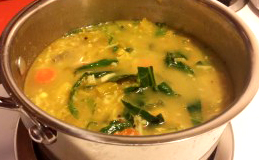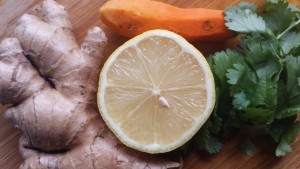
Kitchari is an age old, traditional dish that is not only a staple for Indian meals, but is also a staple for any Ayurvedic cleanse. This versatile, Eastern dish is super nourishing to the body and the mind, and can be made to fit any constitution or dosha type, depending on the spices and veggies that you may decide to add.
This particular recipe is tri-doshic, meaning suitable for all body types, and is fitting as a meal, or to aid in a mono-diet cleanse. Kitchari is well known as being easy on the digestive tract and therefore is also a great option for when you are feeling a bit under the weather.
So however you decide to incorporate this meal, you can play around with this recipe by adding different spices, veggies, oils, and ghee. I often like to use homemade chicken broth to add flavor as well as essential vitamins and nutrients.
- Doshic effect: Vata ↓, Pitta ↓, Kapha ↓* (Kapha types should use quinoa instead of basmati rice)
- Serving: 3-4
- Time: about 60 minutes
Ingredients:
- 1 c split mung dal or red lentils, soaked overnight
- 3/4 c basmati rice (can be substituted for brown rice or quinoa)
- 4-5 c purified water
- 1 carrot, thinly sliced or grated
- 1-2 celery sticks, thinly sliced
- 2-3 leaves of chard, kale or collard greens
- 2 tbsp ghee, coconut oil or sesame oil
- 1 tsp fennel, freshly ground or whole
- 1 tsp cumin, freshly ground or whole
- 1 tsp coriander, freshly ground or whole
- 3-5 black peppercorns, freshly ground
- 1 inch fresh ginger, peeled and finely grated
- Fresh juice from a 1/2 of a lemon
- 5+ sprigs of fresh cilantro, finely chopped
- 1 tsp turmeric
- salt to taste (sea salt or pink Himalayan)
NOTE: If you do not have these particular spices in your kitchen, feel free to replace them all with 2-3 tsp of my Agni Churna spice mixture. This contains all the above spices along with several other digestive strengthening Ayurvedic spices.
Instructions:
- In a medium size sauce pan add the ghee (or sesame oil) along with the cumin, coriander, fennel and black pepper and stir over a medium heat until the spices brown slightly and start to crackle.
- Place the water in the same pan and bring to a boil. Add the mung dal or red lentils and the basmati rice. Reduce the heat to low, stirring occasionally. Cover the pan, leaving a slight opening to prevent the risk of overflow.
- As the beans are cooking, begin to slice up the carrot, celery and greens. Add to the pot, stir, and place back the lid keeping it slightly cracked.
- Keep the ingredients on a low boil for 30-45 minutes or until the beans and veggies are soft (almost mushy) and well cooked.
- Remove from heat. Add cilantro, fresh lemon juice, grated ginger, turmeric and salt to taste.
NOTE: When using whole mung beans and/or brown rice the cooking time will increase. Make sure to use more water and to cook for at least 30 minutes alone before adding the veggies.
